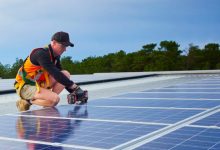The installation of rooftop solar on Queensland’s public buildings, including public libraries, schools and the state’s prisons, could provide a significant boost to the state’s solar capacity, according to new analysis published by the Australian Conservation Foundation (ACF).
The report suggests that there are significant untapped opportunities for the Queensland government to deploy solar on the buildings it owns and manages, creating almost 850 new job opportunities in the process.
According to the ACF report, there is enough spare roof space on Queensland public buildings to install a large solar farm’s worth of rooftop solar, up to 150MW, that would reduce energy costs for public infrastructure, as well as avoiding more than 150,000 tonnes of carbon emissions.
A further 234MW of rooftop solar could be supported on other public-use buildings in Queensland, including solar across private schools, university campuses, sports facilities.
In undertaking the analysis, ACF partnered with the University of New South Wales and the Australian PV Institute to estimate the amount of suitable roof space that was available across public buildings, using a mix of a digital surface model of Queensland and building footprint data.
The analysis examined public buildings across five local government areas, including Brisbane, Townsville, Cairns, Logan and Gladstone, finding that public schools would be the biggest beneficiaries, with enough combined roof space to support 77MW of solar, with an additional 28MW capable of being installed on public hospitals and 14MW on correctional centres.

“This research highlights the huge opportunity the state government has to increase the supply of clean, low-cost electricity to meet the daily energy needs of schools, hospitals and other essential services,” the Australian Conservation Foundation’s Jason Lyddieth said.
“Installing solar on public schools, hospitals, prisons, libraries, fire stations and other public buildings creates jobs and makes the sunshine state part of the climate change solution.”
“This research shows there remains huge potential to generate more clean power – and jobs – by putting solar systems on more public buildings.
The report has been released just two weeks ahead of a Queensland state election, that will be tightly fought between the incumbent Palaszczuk government and the Liberal-National opposition, and ACF hopes that the analysis will work to encourage political leaders to prioritise

“If public buildings in Brisbane, Cairns, Townsville, Logan and Gladstone have 45 football fields worth of rooftops that are suitable for solar, just imagine how much potential there is across the state,” Lyddieth said.
“We call on Annastacia Palaszczuk and Deb Frecklington to commit the next Queensland government to going big with solar on public buildings.”
Clean energy advocates and environmental groups have sought to place the Queensland solar sector at the centre of the state election, which has largely focused on the Palaszczuk government’s response to the Covid-19 pandemic.
The ACF report follows a report commissioned by the Queensland Conservation Council which shows how Queensland could transition to 100 per cent renewable electricity within the next 15-years, with enough solar and wind projects in the development pipeline to help the state transition entirely to zero-emissions sources of electricity.
A separate report published by the Climate Council estimated that there were as many as 20,000 jobs that could be created in Queensland over the next three years through stronger clean energy policies, including a massive boost to the state’s resources sector by supporting the emergence of green manufacturing, including battery production, within Queensland.
As part of its re-election pitch, Queensland Labor has committed to investing $500 million, through its government-owned clean energy investment arm CleanCo, to fund the construction of new wind, solar and storage projects in the state. The Palaszczuk has also committed $145 million to help fund the establishment of up to three renewable energy zones across Queensland.
Liberal-National Party leader Deb Frecklington announced that the opposition party would invest $500 million to ‘reduce power prices’ through a separate entity, Energy Queensland, which currently manages the state-owned Energex and Ergon Energy companies.
The Queensland Greens, looking to increase their presence within the Queensland parliament, have said that they would invest up to $25 billion through Energy Queensland, with the aim of transitioning the state to 100% renewable electricity by 2030, in a plan that would create an average of 23,000 jobs a year.










